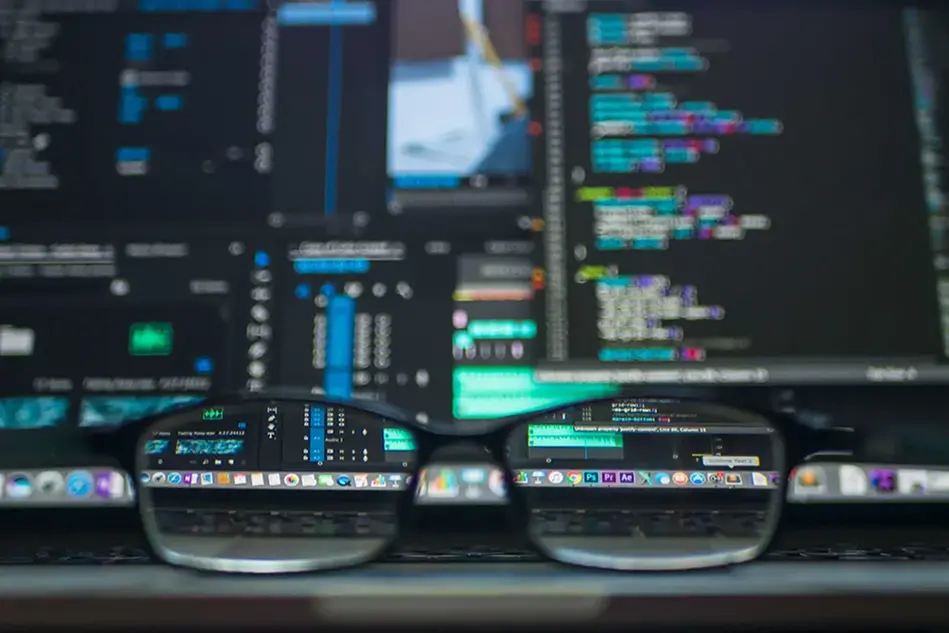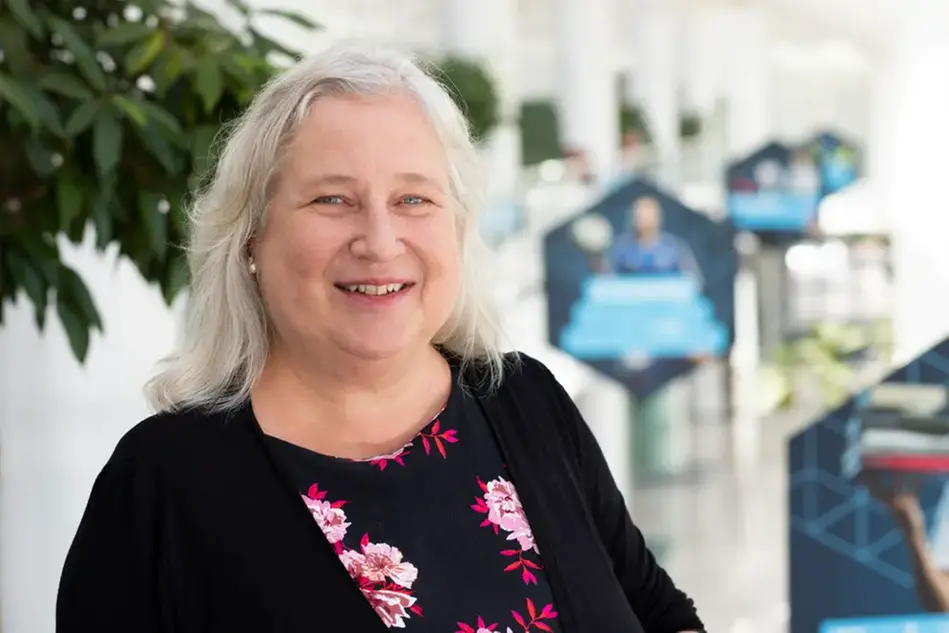Professor’s portrait: “Digitalisation is not an uncontrollable force of nature; it is created by humans”
Digital service innovation is about how digital services are received and create value for users, organisations, and society. Maria Åkesson, Professor of Informatics, study how digitalisation can contribute to service innovation and new business opportunities and, at the same time, how it can challenge business logic in various industries.

“There is a tendency to underestimate the complexity of digitalisation processes. Digitalisation is both faster and slower than expected and achieves both more and less than expected.”
Maria Åkesson, Professor of Informatics at Halmstad University
Maria Åkesson, Professor of Informatics at Halmstad University, focuses her research on digital service innovation, digitalisation and digital transformation. Primarily, she has studied value creation in the newspaper and automotive industry and the public sector.
“It is important to understand digitalisation as an ecosystem and from a service innovation perspective. This means putting people at the centre, to co-create value through interactive processes and critically evaluate digitalisation from the perspective of different stakeholders”, says Maria Åkesson.

Maria Åkesson is a Professor of Informatics at Halmstad University.
From product to digital service
Maria Åkesson’s academic path began in business administration, where her goal was to work in the hotel and restaurant industry. However, during her education, she became interested in administrative data processing, later called informatics.
“I became particularly interested in system development and participatory design, so I ended up also taking a bachelor’s degree in Informatics”, says Maria Åkesson.
Digitalisation in the newspaper industry was one of Maria Åkesson’s first focuses within informatics and digital service innovation.
“The fact that I had studied business economics, service marketing and theories of product and service logic helped me understand that the digitalisation of the newspaper industry meant a shift in perspective – from IT as a product to a digital service”, says Maria Åkesson and continues:
“Together with a colleague, I collaborated for many years with newspaper companies in Japan, Europe and USA, among other places. At first, we worked a lot on designing electronic magazines, and during that time, we had high hopes that they could replace paper magazines. But the technology was not mature enough. That made us shift our focus to how to work with several different communication channels and how journalism could be maintained in the digital world due to the content competition that existed in the digital environment.”
The work resulted in different services within the newspaper industry and generated new business models and strategies for digital publishing.

Maria Åkesson has been working with digitalisation in the newspaper industry.
Predict problems in traffic using digital solutions
After Maria Åkesson received her doctorate in 2009, she continued to study digitalisation and digital service innovation within the automotive industry. That is also the part of her research that has laid the foundation for today’s research profile within informatics and digital service innovation at Halmstad University. Maria Åkesson believes that digitalisation can bring new business opportunities but that it also can challenge existing ways of working:
“Digital service innovation in the automotive industry has, for example, created new opportunities to offer customers digital services connected to vehicles through remote diagnostics.”
In a research project with Volvo, remote diagnostics were used to prevent accidents and stoppages in local traffic caused by buses.
“Our work involved investigating which problems bus operators experience, that could be solved with remote diagnostics. We looked at how digital services based on remote diagnostics could be designed to fix the bus before a problem occur – or maybe even prevent it from happening – through the technical information received through the bus's sensors”, says Maria Åkesson.
Digitalisation challenges and develops industries
Maria Åkesson has seen how different business logics have been challenged, not least in the newspaper industry. She describes a digitalisation journey that has been going on for more than 20 years and that has fundamentally changed the ecosystem of industries.
In addition to having studied the newspaper and automotive industry, Maria Åkesson also studies how digitalisation, more specific automation of administrative work, affects the working environment of employees and the bureaucratic performance of services in the public sector. The goal is to be able to design digital solutions, specifically digital automation, that could contribute to a good working environment for the employees, functioning bureaucracy and, by extension, the greater good of society.
“We want to contribute to joint learning in these projects by problematising and discussing with those who work in the municipalities”, says Maria Åkesson.
Dealing with the paradoxes of digitalisation
Digitalisation contains many paradoxes. Maria Åkesson believes that we like to set ambitious agendas for digitalisation processes and visionary goals about the digital society – but it often does not go as planned.
“There is a tendency to underestimate the complexity of digitalisation processes. Digitalisation is both faster and slower than expected and achieves both more and less than expected. It is well known that digitalisation can have positive consequences or unexpected positive consequences. However, it is equally well known that digitalisation can also have unforeseen and unwanted consequences. These paradoxes have been observed by informatics researchers since the 1960s and seem to be a constant current problem area”, says Maria Åkesson.
One way to deal with these paradoxes, says Maria Åkesson, is to understand and admit that it is we, ourselves, who design digitalisation and digital transformation:
“Digitalisation is not an uncontrollable force of nature; it is created by humans.”
Acknowledgement of her research contribution
Since 1993, Maria Åkesson has been involved in the construction and development of both education and research in the field of Informatics at Halmstad University. She hopes that the results of the research she conducts with her colleagues will be useful through, among other things, collaboration in research projects and for the students. In addition to research, she is a Programme Director and teacher at the Master’s programme in Digital Service Innovation at the University and also supervises PhD students.
“The students are an important part of our future”, says Maria Åkesson.
In March 2022, Maria Åkesson was appointed Professor of Informatics at Halmstad University:
“To be appointed Professor is a fine acknowledgement of my competence and the research we conduct in Informatics at Halmstad University.”
In the future, Maria Åkesson hopes for new interdisciplinary collaborations, which the University’s recent investments in research programmes offer. For example, she is one of the researchers in the research programme LeaDs (Learning in a Digital Society), which focuses on digitalisation in different learning environments.
Text: Anna-Frida Agardson
Top illustration: Unsplash
Portrait: Dan Bergmark
Picture: Pixabay
About Maria Åkesson, Professor of Informatics. Appointed in 2022
What is your education?
“I have a bachelor’s degree in Business Administration and in Informatics, both from Halmstad University. I took my master’s degree in Informatics and PhD at the University of Gothenburg.”
When did you start working at Halmstad University?
“I have worked at the University since 1993. At that time, I was a teacher employed by the hour.”
When and where did you do your dissertation?
“I defended my dissertation in 2009 at the University of Gothenburg with my thesis “’Digital Innovation in the Value Networks of Newspapers’”.
What did you do after that?
“I was appointed Excellent Teacher in 2019. I have been Director of Studies for Informatics, Head of Department for MI-lab and a member of the Research and Education Board (FUN). I am the Programme Director for the Master’s programme in Digital Service Innovation, a member of the University Governing Board and the Management Group for doctoral education at the School of Information Technology.”
Who have you collaborated with in your research?
“At Halmstad University, I have collaborated with other researchers in informatics. I have also conducted multidisciplinary collaborations with researchers in, for example, political science, human work science and computer science. Outside the University, I have collaborated with researchers from, among others, the University of Gothenburg, Linköping University, KTH, the London School of Economics and Ryerson University in Canada.”
“Within the newspaper industry, I have collaborated with many media companies and newspapers, both in Sweden and internationally, for example, Tidningsutgivarna, Stampen, Bonniers, Mittmedia, Schibsted, Concentra Media, Göteborgsposten, Sydsvenskan, Dagens Nyheter, Aftonbladet, Expressen, Boston Globe, New York Times and Yomiuri Shimbun. I have also supervised two PhD students who completed their thesis work in collaboration with the Volvo Group. In recent years, my colleagues and I have collaborated with Halmstad and Kungsbacka municipalities. The research has been financed by, among others, the Knowledge Foundation, Vinnova and Afa Försäkring.”

